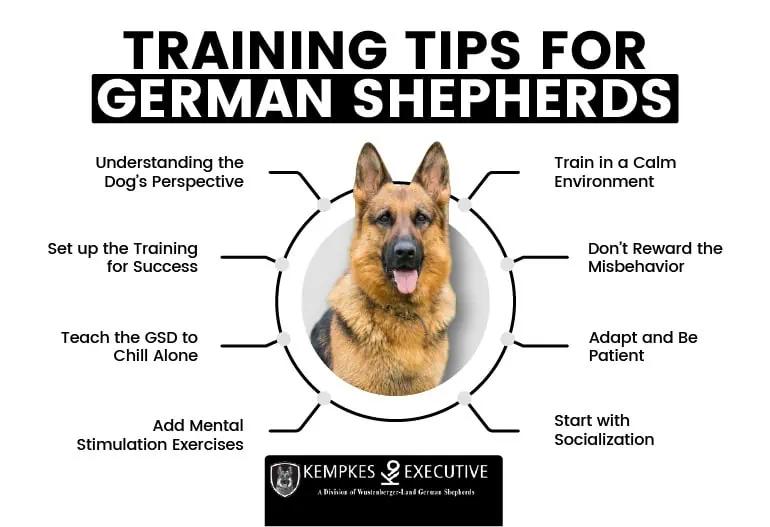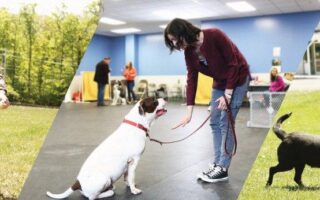Unlocking the Potential of the German Shepherd: A Journey Through Training
In a world where devotion meets intelligence, few canine companions exemplify this bond like the German Shepherd. Renowned for their loyalty, versatility, and unwavering love, these majestic dogs have won hearts and homes across the globe. However, the journey to cultivating a well-behaved and balanced German Shepherd is not solely dependent on their innate qualities; it requires a foundation built on effective training techniques, patience, and understanding. This article explores the essential aspects of German Shepherd training, guiding new and seasoned owners alike through the process of transforming their spirited pups into well-mannered members of the family. Whether you are embarking on this adventure for the first time or seeking to refine your approach, join us as we dive into the world of German Shepherd training and uncover the secrets to unlocking their full potential.
Table of Contents
- Fundamentals of Bonding and Trust in German Shepherd Training
- Effective Techniques for Obedience and Behavioral Cohesion
- Socialization Strategies for a Well-Rounded German Shepherd
- Mental Stimulation Activities to Enhance Training Success
- Q&A
- Concluding Remarks
Fundamentals of Bonding and Trust in German Shepherd Training
Establishing a strong connection with your German Shepherd is essential for effective training. This bond not only enhances the dog’s responsiveness but also fosters mutual respect and understanding. To cultivate this trust, consider the following approaches:
- Consistency: Maintain a predictable routine during training sessions to help your dog understand what to expect.
- Positive Reinforcement: Use rewards like treats, praise, or play to encourage desired behaviors, reinforcing the connection between actions and outcomes.
- Patience: Every dog learns at their own pace; be patient to avoid frustration for both you and your pet.
Moreover, training should be perceived as a collaborative experience rather than a chore. Engage your German Shepherd in fun and stimulating activities that strengthen your relationship while enhancing their skills. Here’s a simple example of a training schedule that could help you maintain focus:
| Day | Activity | Duration |
|---|---|---|
| Monday | Basic Commands | 15 Minutes |
| Tuesday | Agility Training | 30 Minutes |
| Wednesday | Socialization Walk | 20 Minutes |
| Thursday | Trick Training | 25 Minutes |
| Friday | Free Play | 40 Minutes |
Effective Techniques for Obedience and Behavioral Cohesion
Training a German Shepherd requires a blend of patience, consistency, and the right techniques to foster obedience and ensure behavioral cohesion. Utilizing positive reinforcement is one of the most effective methods; rewarding desired behaviors encourages your dog to repeat them. Here are some additional techniques to consider:
- Set Clear Boundaries: Establish what behaviors are acceptable and which are not, so your dog understands expectations.
- Socialization: Expose your German Shepherd to various environments, people, and other animals to build confidence and prevent fear-based reactions.
- Regular Training Sessions: Consistency is key; short daily training sessions are more effective than infrequent long ones.
- Use Variety in Training: Incorporate different commands and tricks to maintain your dog’s interest and engagement.
In implementing these techniques, it can be helpful to track progress, ensuring that both you and your German Shepherd stay motivated. Creating a simple training schedule may provide the structure needed. Below is a basic format for a weekly training plan:
| Day | Activity | Duration |
|---|---|---|
| Monday | Basic Commands | 15 min |
| Tuesday | Socialization Walks | 30 min |
| Wednesday | Agility Training | 20 min |
| Thursday | Trick Training | 25 min |
| Friday | Review Commands | 15 min |
| Saturday | Play & Bonding Time | 30 min |
| Sunday | Rest & Relaxation | – |
Socialization Strategies for a Well-Rounded German Shepherd
Mental Stimulation Activities to Enhance Training Success
Mental stimulation is just as crucial as physical exercise when it comes to training your German Shepherd. Engaging your dog’s brain fosters a deeper bond and improves learning outcomes. Consider incorporating puzzle toys and interactive games into your training routine. These activities provide both fun and function, challenging your dog to think critically while they work to attain a reward. Whether it’s hiding treats inside a toy or teaching them to navigate an obstacle course with various puzzles, stimulating their intellect will help maintain their focus and drive during training sessions.
Another effective approach to enhance your dog’s training success is to use obedience games and trick training. These activities can be not only entertaining but also serve to reinforce basic commands. For instance, teaching your German Shepherd to play hide and seek or fetch specific items can give them a purpose and keep their minds sharp. Try setting up a structured schedule where you alternate between basic commands and fun tricks to keep the sessions fresh. Below is a simple table outlining different mental stimulation activities:
| Activity | Description |
|---|---|
| Puzzle Toys | Interactive toys that require problem-solving to access treats. |
| Hide and Seek | Teaching your dog to find you or hidden treats in the house. |
| Trick Training | Learning fun tricks that stimulate the dog’s mind. |
| Obstacle Course | Setting up mini challenges that combine commands and agility. |
Q&A
Q&A: The Ultimate Guide to German Shepherd Training
Q1: Why is training important for German Shepherds?
A: Training is crucial for German Shepherds due to their intelligence and strong working instincts. Without proper training, these dogs can become bored, leading to behavioral issues. Training not only fosters discipline and good manners but also strengthens the bond between you and your furry companion.
Q2: What are the key principles to follow when training a German Shepherd?
A: The key principles include consistency, positive reinforcement, patience, and socialization. Consistency helps your dog understand expectations, while positive reinforcement encourages desired behaviors. Patience is vital as each dog has its own learning pace. Socializing your German Shepherd with diverse environments and people prepares them for various situations and reduces fear or aggression.
Q3: At what age should training begin for a German Shepherd?
A: Training can begin as early as eight weeks old, during the critical socialization period. Early training focuses on basic commands and socialization with other animals and people. However, formal obedience training typically starts around six months of age, when your puppy’s attention span and capacity to learn have increased.
Q4: What are some essential commands every German Shepherd should master?
A: Essential commands include “Sit,” “Stay,” “Come,” “Down,” and ”Heel.” These commands establish a foundation for good behavior and control, especially in public settings. Teaching these commands can enhance your dog’s safety and reliability while fostering a sense of accomplishment for both the dog and the owner.
Q5: How can I address behavioral issues during training?
A: Addressing behavioral issues requires identifying the root cause, which could stem from boredom, anxiety, or lack of exercise. Redirecting negative behaviors through positive reinforcement, providing ample physical activity, and ensuring mental stimulation can significantly reduce issues. Additionally, addressing any underlying anxiety with professional help might be necessary for more severe cases.
Q6: How important is a socialization program for a German Shepherd?
A: Socialization is incredibly important for German Shepherds, as it helps them develop into well-adjusted adults. Exposing your dog to various people, animals, and environments helps prevent fearfulness and aggression. A well-socialized German Shepherd is typically more confident and easier to train, making outings more enjoyable for everyone.
Q7: Are there any specific training techniques recommended for German Shepherds?
A: Techniques such as clicker training, leash training, and agility training are particularly effective for German Shepherds. Clicker training uses a sound to mark desired behaviors, reinforcing them with treats. Leash training is essential, especially since German Shepherds are strong and can easily pull. Agility training taps into their intelligence and energy, providing both physical and mental exercise.
Q8: How can I keep training sessions engaging for my German Shepherd?
A: Keeping training sessions fun and engaging can be achieved through varied activities, incorporating games, rewards, and short sessions that prevent boredom. Use toys or treats as motivation and switch up your locations to keep your dog curious and eager to learn. Remember to celebrate small victories to maintain enthusiasm!
Q9: Should I consider professional training classes for my German Shepherd?
A: Professional training classes can be beneficial, especially for first-time dog owners or those facing specific behavioral challenges. A knowledgeable trainer can provide structured learning, socialization opportunities, and personalized advice based on your dog’s unique temperament. Group classes also offer the opportunity to socialize your dog with other dogs and people.
Q10: What should I do if I feel overwhelmed by training my German Shepherd?
A: Feeling overwhelmed is completely normal! Training takes time and patience. If you find yourself struggling, consider taking breaks, seeking advice from professional trainers, or joining local training groups. Remember, the goal is to create a positive experience for both you and your dog, and asking for help is always a smart option.
Concluding Remarks
training your German Shepherd is not just about instilling obedience; it’s about forging a deep, lasting bond between you and your canine companion. As you embark on this rewarding journey, remember that patience, consistency, and positive reinforcement are your greatest allies. Each command learned and each trick mastered is a step toward a harmonious partnership that will enrich both your lives. Whether you’re navigating basic obedience or exploring advanced skills, the time and effort you invest will yield a loyal, well-mannered friend who’s ready to take on the world by your side. Embrace the adventure ahead, and watch as your German Shepherd transforms into not just a pet, but a true member of your family. Happy training!


